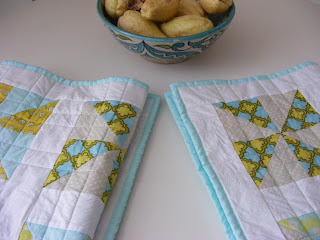Cutting is an essential part of quilting and I personally enjoy it very much, particularly after I got myself an Olfa rotary cutter and a cutting mat. Believe or not, I only did so recently. I used to cut everything with scissors but I wouldn't go back now. Even though quilting has been around long before rotary cutters and mats were invented and one can do perfectly alright without them, once you’ve got the hang of it they become absolutely indispensable because it’s so much quicker and accurate!
Cutting should be done parallel to the grain of the fabric. Doing so, you will avoid unnecessary distortion that can make sewing difficult. So fold your fabric lengthwise with selvages together and adjust until it is straight. Use the fold as a guide to align the fabric with the grid of your cutting mat, set your ruler in place and cut the stripe. The turn around the stripe and cut the squares. I find it easier to cut in the vertical direction than in the horizontal. Never use the selvages; they have a different thickness and behavior and will distort your pieces!
Also, don’t apply more pressure than necessary with the rotary cutter or your hands will be sore and your cutting mat will have a shorter lifespan.
In case you’re wondering, I use a common ruler rather than a quilter’s ruler because it has suited me perfectly well until now. I just follow the grid of my cutting mat. But remember I was the one who cut fabric with scissors until recently!
Don't throw away right now the tiny bits leftover from cutting stripes into squares. They have all the same height and will be very useful later...





























